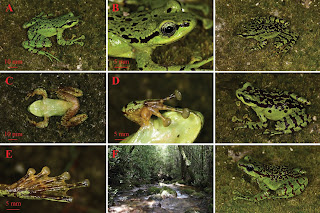 |
| Amolops gudao Yu, Wu, Lu & Che, in Wu, Yu, Kilunda, Lu, J.-H. Li, Y.-P. Li, Shi et Che. 2025. Gudao Cascade Frog | 古道湍蛙 || DOI: doi.org/10.3897/zookeys.1227.131357 |
Abstract
The Gaoligong Mountains lie at the intersection of three global biodiversity hotspots. In recent years, with the continuous deepening of fieldwork in the region, studies have increasingly indicated that the amphibian diversity of this region remains poorly understood. During herpetological surveys in 2023, a series of Amolops specimens were collected from the Gaoligong Mountains of Yunnan Province, China. The integrated results of morphological and molecular phylogenetic analyses indicate the presence of a separate and previously unknown lineage in the A. viridimaculatus group, which we herein confirm as a new species, Amolops gudao Yu, Wu, Lu & Che, sp. nov. Our discovery increases the number of Amolops species recorded in China to 59, and the total number of Amolops species to 86. The discovery of a new species in the Gaoligong Mountains further highlights the underestimated amphibian diversity in the region, emphasizing the need for continued fieldwork and research. Furthermore, Amolops gudao Yu, Wu, Lu & Che, sp. nov. exhibits obvious intraspecific variation in color patterns, a phenomenon also reported in several species within the A. viridimaculatus group, such as A. viridimaculatus and A. kaulbacki. Future studies on the taxonomy of A. viridimaculatus group should be careful with the use of color patterns as a diagnostic characteristic.
Key words: Amolops viridimaculatus group, diversity, new species, phylogeny, sympatric species, Yunnan Province
Amolops gudao Yu, Wu, Lu & Che, sp. nov.
Diagnosis. The new species is recognized as a member of the A. viridimaculatus group based on molecular phylogenetic analyses and can be distinguished from its groups by a combination of the following characters (Suppl. material 3): (1) medium body size (SVL 56.7–58.6 mm in males and 63.6–64.8 mm in females); (2) vomerine teeth developed, on two short oblique between choanae, “八”-shaped, almost equal in distance from each other as to choanae; (3) supratympanic fold indistinct; (4) true dorsolateral folds absent, discontinuous glandular dorsolateral fold from rear of eye to near vent present; (5) tongue cordiform, 1/2 notched posteriorly; (6) maxillary teeth developed; (7) circummarginal grooves present on tips of outer three fingers, absent on first finger; (8) inner metacarpal tubercle rounded, outer metacarpal tubercle indistinct; (9) tibiotarsal articulation of adpressed limb reaching the anterior corner of eye; (10) a black stripe below edge of the canthus rostralis extending from the nostril across the eyes, along dorsolateral glandular folds to near vent; (11) rictal gland absent; (12) iris distinctly bicolored, green in upper 1/4 and reddish brown in lower 3/4, black reticulations throughout; (13) vocal sac absent in males; (14) male with orange nuptial pad at the base of first finger.
Etymology Baihualing, where the new species occurs, lies on the historical passage of the famous Southern Silk Road. The specific epithet gudao is derived from the Chinese alternative name for the Southern Silk Road.
We propose the English common name Gudao Cascade Frog and the Chinese common name Gǔ Dào Tuān Wā (古道湍蛙).
Yun-He Wu, Zhong-Bin Yu, Felista Kasyoka Kilunda, Chen-Qi Lu, Jia-Hua Li, Yun-Peng Li, Yi-Juan Shi and Jing Che. 2025. A New Species of the Genus Amolops (Anura, Ranidae) from the Gaoligong Mountains, China. ZooKeys. 1227: 349-367. DOI: doi.org/10.3897/zookeys.1227.131357


